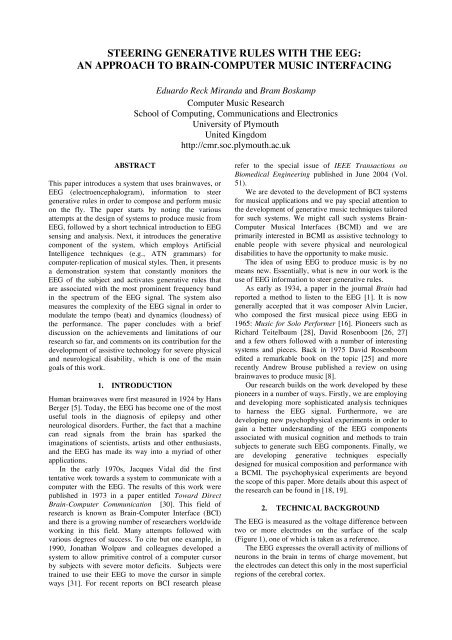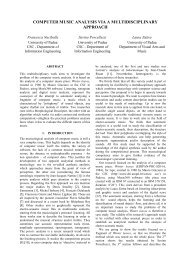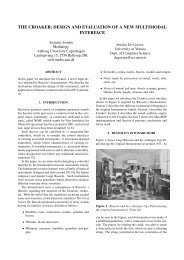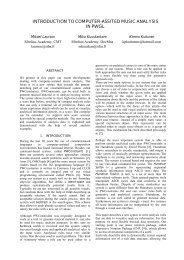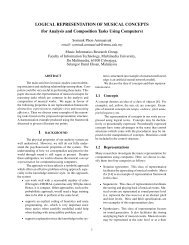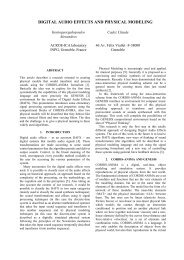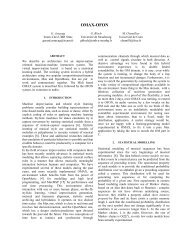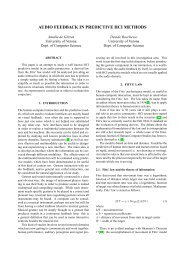STEERING GENERATIVE RULES WITH THE EEG: AN ... - CiteSeer
STEERING GENERATIVE RULES WITH THE EEG: AN ... - CiteSeer
STEERING GENERATIVE RULES WITH THE EEG: AN ... - CiteSeer
You also want an ePaper? Increase the reach of your titles
YUMPU automatically turns print PDFs into web optimized ePapers that Google loves.
<strong>STEERING</strong> <strong>GENERATIVE</strong> <strong>RULES</strong> <strong>WITH</strong> <strong>THE</strong> <strong>EEG</strong>:<br />
<strong>AN</strong> APPROACH TO BRAIN-COMPUTER MUSIC INTERFACING<br />
Eduardo Reck Miranda and Bram Boskamp<br />
Computer Music Research<br />
School of Computing, Communications and Electronics<br />
University of Plymouth<br />
United Kingdom<br />
http://cmr.soc.plymouth.ac.uk<br />
ABSTRACT<br />
This paper introduces a system that uses brainwaves, or<br />
<strong>EEG</strong> (electroencephalogram), information to steer<br />
generative rules in order to compose and perform music<br />
on the fly. The paper starts by noting the various<br />
attempts at the design of systems to produce music from<br />
<strong>EEG</strong>, followed by a short technical introduction to <strong>EEG</strong><br />
sensing and analysis. Next, it introduces the generative<br />
component of the system, which employs Artificial<br />
Intelligence techniques (e.g., ATN grammars) for<br />
computer-replication of musical styles. Then, it presents<br />
a demonstration system that constantly monitors the<br />
<strong>EEG</strong> of the subject and activates generative rules that<br />
are associated with the most prominent frequency band<br />
in the spectrum of the <strong>EEG</strong> signal. The system also<br />
measures the complexity of the <strong>EEG</strong> signal in order to<br />
modulate the tempo (beat) and dynamics (loudness) of<br />
the performance. The paper concludes with a brief<br />
discussion on the achievements and limitations of our<br />
research so far, and comments on its contribution for the<br />
development of assistive technology for severe physical<br />
and neurological disability, which is one of the main<br />
goals of this work.<br />
1. INTRODUCTION<br />
Human brainwaves were first measured in 1924 by Hans<br />
Berger [5]. Today, the <strong>EEG</strong> has become one of the most<br />
useful tools in the diagnosis of epilepsy and other<br />
neurological disorders. Further, the fact that a machine<br />
can read signals from the brain has sparked the<br />
imaginations of scientists, artists and other enthusiasts,<br />
and the <strong>EEG</strong> has made its way into a myriad of other<br />
applications.<br />
In the early 1970s, Jacques Vidal did the first<br />
tentative work towards a system to communicate with a<br />
computer with the <strong>EEG</strong>. The results of this work were<br />
published in 1973 in a paper entitled Toward Direct<br />
Brain-Computer Communication [30]. This field of<br />
research is known as Brain-Computer Interface (BCI)<br />
and there is a growing number of researchers worldwide<br />
working in this field. Many attempts followed with<br />
various degrees of success. To cite but one example, in<br />
1990, Jonathan Wolpaw and colleagues developed a<br />
system to allow primitive control of a computer cursor<br />
by subjects with severe motor deficits. Subjects were<br />
trained to use their <strong>EEG</strong> to move the cursor in simple<br />
ways [31]. For recent reports on BCI research please<br />
refer to the special issue of IEEE Transactions on<br />
Biomedical Engineering published in June 2004 (Vol.<br />
51).<br />
We are devoted to the development of BCI systems<br />
for musical applications and we pay special attention to<br />
the development of generative music techniques tailored<br />
for such systems. We might call such systems Brain-<br />
Computer Musical Interfaces (BCMI) and we are<br />
primarily interested in BCMI as assistive technology to<br />
enable people with severe physical and neurological<br />
disabilities to have the opportunity to make music.<br />
The idea of using <strong>EEG</strong> to produce music is by no<br />
means new. Essentially, what is new in our work is the<br />
use of <strong>EEG</strong> information to steer generative rules.<br />
As early as 1934, a paper in the journal Brain had<br />
reported a method to listen to the <strong>EEG</strong> [1]. It is now<br />
generally accepted that it was composer Alvin Lucier,<br />
who composed the first musical piece using <strong>EEG</strong> in<br />
1965: Music for Solo Performer [16]. Pioneers such as<br />
Richard Teitelbaum [28], David Rosenboom [26, 27]<br />
and a few others followed with a number of interesting<br />
systems and pieces. Back in 1975 David Rosenboom<br />
edited a remarkable book on the topic [25] and more<br />
recently Andrew Brouse published a review on using<br />
brainwaves to produce music [8].<br />
Our research builds on the work developed by these<br />
pioneers in a number of ways. Firstly, we are employing<br />
and developing more sophisticated analysis techniques<br />
to harness the <strong>EEG</strong> signal. Furthermore, we are<br />
developing new psychophysical experiments in order to<br />
gain a better understanding of the <strong>EEG</strong> components<br />
associated with musical cognition and methods to train<br />
subjects to generate such <strong>EEG</strong> components. Finally, we<br />
are developing generative techniques especially<br />
designed for musical composition and performance with<br />
a BCMI. The psychophysical experiments are beyond<br />
the scope of this paper. More details about this aspect of<br />
the research can be found in [18, 19].<br />
2. TECHNICAL BACKGROUND<br />
The <strong>EEG</strong> is measured as the voltage difference between<br />
two or more electrodes on the surface of the scalp<br />
(Figure 1), one of which is taken as a reference.<br />
The <strong>EEG</strong> expresses the overall activity of millions of<br />
neurons in the brain in terms of charge movement, but<br />
the electrodes can detect this only in the most superficial<br />
regions of the cerebral cortex.
There are basically two conventions for positioning<br />
the electrodes on the scalp: the 10-20 Electrode<br />
Placement System (as recommended by the International<br />
Federation of Societies for <strong>EEG</strong> and Clinical<br />
Neurophysiology), and the Geodesic Sensor Net<br />
(developed by a firm called Electric Geodesics, Inc.).<br />
The former is more popular and is the convention<br />
adopted for the systems described in this paper: it uses<br />
electrodes placed at positions that are measured at 10%<br />
and 20% of the head circumference (Figure 2). In this<br />
case, the terminology for referring to the position of the<br />
electrodes uses a key letter that indicates a region on the<br />
scalp and a number: F = frontal, Fp = frontopolar, C =<br />
central, T = temporal, P = parietal, O = occipital and A<br />
= auricular (the ear lobe; not shown in Figure 2). Odd<br />
numbers are for electrodes on the left side of the head<br />
and even numbers are for those on the right side.<br />
The set of electrodes being recorded at one time is<br />
called a montage. Montages fall into one of two<br />
categories: referential or bipolar. Referential means that<br />
the reference for each electrode is in common with other<br />
electrodes; for example, each electrode may be<br />
referenced to an electrode placed on the earlobe. An<br />
average reference means that each electrode is<br />
compared to the average potential of every electrode.<br />
Bipolar means that each channel is composed of two<br />
neighbouring electrodes; for example, channel 1 could<br />
be composed of Fp1-F3, where Fp1 is the active<br />
electrode and F3 is the reference, then channel 2 could<br />
be composed of Fp2-F4, where Fp2 is the active<br />
electrode and C4 is the reference; and so forth.<br />
Figure 1. Brainwaves can be detected with electrodes<br />
placed on the scalp.<br />
The <strong>EEG</strong> is a difficult signal to handle because it is<br />
filtered by the meninges (the membranes that separate<br />
the cortex from the skull), the skull and the scalp before<br />
it reaches the electrodes. Furthermore, the signals<br />
arriving at the electrodes are sums of signals arising<br />
from many possible sources, including artifacts like the<br />
heartbeat and eye blinks. Although experts can diagnose<br />
brain malfunctioning from raw <strong>EEG</strong> plots, this signal<br />
needs to be further scrutinized with signal processing<br />
and analysis techniques in order to be of any use for a<br />
BCI system.<br />
Figure 2. The 10-20 electrode placement system.<br />
2.1. <strong>EEG</strong> Analysis<br />
There are a number of approaches to <strong>EEG</strong> analysis,<br />
such as power spectrum, spectral centroid, Hjorth,<br />
event-related potential (ERP), principal component<br />
analysis (PCI), correlation, to cite but a few. Brief<br />
non-mathematical introductions to <strong>EEG</strong> power<br />
spectrum and Hjorth analyses are given below due to<br />
their relevance to our system. A discussion on other<br />
analysis techniques and how they have been used in<br />
neuroscience of music research can be found in<br />
references such as [6, 13, 14, 21, 29].<br />
Power spectrum analysis is derived from<br />
techniques of Fourier analysis, such as the Discrete<br />
Fourier Transform (DFT). In short, DFT analysis<br />
breaks the <strong>EEG</strong> signal into different frequency bands<br />
and reveals the distribution of power between them.<br />
This is useful because the distribution of power in the<br />
spectrum of the <strong>EEG</strong> can reflect certain states of mind.<br />
For example, a spectrum with salient low-frequency<br />
components can be associated with a state of<br />
drowsiness, whereas a spectrum with salient highfrequency<br />
components could be associated with a state<br />
of alertness. There are five recognised frequency<br />
bands of <strong>EEG</strong> activity, also referred to as <strong>EEG</strong><br />
rhythms, each of which is associated with specific<br />
mental states: delta, theta, alpha, low beta and high<br />
beta rhythms. They certainly indicate different mental<br />
states, but there is, however, some controversy as to<br />
the exact boundaries of these bands and the mental<br />
states with which they are associated.<br />
Hjorth introduced an interesting method for<br />
clinical <strong>EEG</strong> analysis [12], which measures three<br />
attributes of the signal: its activity, mobility and<br />
complexity. Essentially, it is a time-based amplitude<br />
analysis. This method is interesting because it<br />
represents each time step (or window) using only these<br />
three attributes and this is done without conventional<br />
frequency domain description. The signal is measured
for successive epochs (or windows) of one to several<br />
seconds. Two of the attributes are obtained from the<br />
first and second time derivatives of the amplitude<br />
fluctuations in the signal. The first derivative is the<br />
rate of change of the signal’s amplitude. At peaks and<br />
troughs the first derivative is zero. At other points it<br />
will be positive or negative depending on whether the<br />
amplitude is increasing or decreasing with time. The<br />
steeper the slope of the wave, the greater will be the<br />
amplitude of the first derivative. The second derivative<br />
is determined by taking the first derivative of the first<br />
derivative of the signal. Peaks and troughs in the first<br />
derivative, which correspond to points of greatest<br />
slope in the original signal, result in zero amplitude in<br />
the second derivative, and so forth.<br />
Activity is the variance of the amplitude<br />
fluctuations in the epoch. Mobility is calculated by<br />
taking the square root of the variance of the first<br />
derivative divided by the variance of the primary<br />
signal. Complexity is the ratio of the mobility of the<br />
first derivative of the signal to the mobility of the<br />
signal itself. A sinewave has a complexity equal to 1.<br />
Figure 3 shows an example of Hjorth analysis. A raw<br />
<strong>EEG</strong> signal is plotted at the top (C:1) and its<br />
respective Hjorth analysis is plotted below: activity<br />
(C:2), mobility (C:3) and complexity (C:4).<br />
Figure 3. An example of Hjorth analysis.<br />
There is no clear agreement as to what these<br />
measurements mean in terms of mental states. It is<br />
common sense to assume that the longer a subject<br />
remains focused on a specific mental task, the more<br />
stable is the signal, and therefore the lower is the<br />
variance of the amplitude fluctuation. However, this<br />
point questions the possible affects of fatigue,<br />
habituation and boredom, which we have not yet<br />
accounted for in our research.<br />
2.2. Generative Rules<br />
The system uses a rule system that generates music,<br />
based on given examples. The <strong>EEG</strong>-signals can<br />
influence in a well-defined way the mixture of<br />
different style-elements found in the different musical<br />
examples given to train the system. It can generate<br />
music that contains, for example, more Schumann-like<br />
elements when the spectrum of the subject’s <strong>EEG</strong><br />
contains salient low-frequency components and more<br />
modern or jazzy elements when the spectrum of the<br />
<strong>EEG</strong> contains salient high-frequency components.<br />
(These associations are arbitrary.)<br />
Example-based musical-generation systems are often<br />
based on formalisms such as transition networks or<br />
Markov Chains to re-create the transition-logic of whatfollows-what,<br />
either at the level of notes [15] or at the<br />
level of similar “vertical slices” of music [9, 10]. For<br />
example, David Cope uses such example-based musicalgeneration<br />
methods but adds phrase-structure rules,<br />
higher-level composition structure rules, and wellplaced<br />
signatures, earmarks and unifications [9, 10]. The<br />
act of recombining the building blocks of music material<br />
together with some typical patterns and structural<br />
methods has proved to have great musical potential.<br />
This type of self-learning predictors of musical elements<br />
based on previous musical elements could be used on<br />
any level or for any type of musical element such as:<br />
musical note, chord, bar, phrase, section, and so on.<br />
However, there must be logical relations on all those<br />
levels; if a musical note is very close related to its<br />
predecessor(s) then a list of predecessors can predict<br />
quite well what note will follow. The same holds true<br />
for chords, phrase-level, and section-level elements.<br />
For the moment, we have chosen to stick to a<br />
statistical predictor at the level of short vertical slices of<br />
music such as a bar or half-bar, where the predictive<br />
characteristics are determined by the chord (harmonic<br />
set of pitches, or pitch-class) and by the first melodic<br />
note following the melodic notes in those vertical slices<br />
of music (see example below).<br />
We implemented a simple method for generating<br />
short musical phrases with a beginning and an end that<br />
also allows for real-time steering with <strong>EEG</strong> information.<br />
The system generates musical sequences by defining<br />
top-level structures of sentences and methods of<br />
generating similarity- or contrast-relationships between<br />
elements. Consider the following example (LISP-like<br />
notation):<br />
S -> (INC BAR BAR BAR BAR BAR<br />
HALF-CADENCE 8BAR-COPY)<br />
From this top-level, we then generate rules for<br />
selecting a valid musical building block for each<br />
symbol, including rules for incorporating the <strong>EEG</strong><br />
information in all decisions. For example:<br />
INC ->((EQUAL 'MEASURE 1)<br />
(EQUAL 'COMPOSER<br />
<strong>EEG</strong>-SET-COMPOSER))<br />
BAR ->((CLOSE 'PITCH 'PREV-PITCH-LEADING)<br />
(CLOSE 'PITCH-CLASS<br />
'PREV-PITCH-CLASS-LEADING)<br />
(EQUAL 'COMPOSER<br />
<strong>EEG</strong>-SET-COMPOSER))<br />
This defines a network that generates a valid<br />
sentence with a beginning and an end, including real-
time <strong>EEG</strong> control through the variable <strong>EEG</strong>-SET-<br />
COMPOSER. The generative engine will find a musical<br />
element for each of the constraint-sets that are generated<br />
above from INC and BAR, by applying the list of<br />
constraints in left-to-right order to the set of all musical<br />
elements until there are no constraints left, or there is<br />
only one musical element left. This means that it can<br />
happen that some of the given constraints are not<br />
applied.<br />
The database of all musical elements contains music<br />
from different composers, with elements tagged by their<br />
musical function such as measure 1 for the start of a<br />
phrase, cadence for the end, composer for the composer,<br />
and the special tags pitch and pitch-class that are both<br />
used for correct melodic and harmonic progression or<br />
direction. The selection process is illustrated below.<br />
The example database in the Appendix shows the<br />
main attributes that are used to recombine musical<br />
elements. P-CLASS (for pitch-class) is a list of two<br />
elements. The first is the list of start-notes, transposed to<br />
the range of 0-11. The second is the list of all notes in<br />
this element (also transposed to 0-11). P is the pitch of<br />
the first (and highest) melodic note in this element; by<br />
matching this with the melodic note that the previous<br />
element was leading up to we can generate a melodic<br />
flow that adheres in some way to the logic of “where the<br />
music wants to go”. The PCL (for pitch-class leading)<br />
elements contain the same information about the<br />
original next bar; this is used to find a possible next bar<br />
in the recombination process. Then there are the INC,<br />
BAR, and CAD elements. These are used for establishing<br />
whether those elements can be used for phrase-starts<br />
(incipient), or cadence.<br />
Simply by combining the musical elements with the<br />
constraint-based selection process that follows from the<br />
terminals of the phrase-structure rewrite-rules, we end<br />
up with a generative method that can take into account<br />
the <strong>EEG</strong> information. This generates musical phrases<br />
with a domino-game like building block connectivity:<br />
((EQUAL 'MEASURE 1)<br />
(EQUAL 'COMPOSER <strong>EEG</strong>-SET-COMPOSER))<br />
Assuming that there are also musical elements<br />
available from composers other than SCHU, the first<br />
constraint will limit the options to all incipient measures<br />
from all musical elements from all composers. The<br />
second constrains will then limit the options according<br />
to the current <strong>EEG</strong> analysis to the composer that is<br />
associated with the current <strong>EEG</strong> activity, as follows:<br />
((CLOSE 'PITCH 'PREV-PITCH-LEADING)<br />
(CLOSE 'PITCH-CLASS<br />
'PREV-PITCH-CLASS-LEADING)<br />
(EQUAL 'COMPOSER <strong>EEG</strong>-SET-COMPOSER))<br />
In the given phrase structure, the rule that follows<br />
from BAR then defines the constraints put upon a valid<br />
continuation of the music. These constrains will limit<br />
the available options one by one and will order them<br />
according to the defined rule preferences. The CLOSE<br />
constraint will order the available options according to<br />
their closeness to the stored value. For example, after<br />
choosing:<br />
(SCHU-1-1-MEA-1<br />
P-CLASS ((0 4) (0 3 4 6 7 9))<br />
P 76<br />
PCL ((2 7 11)(2 5 7 9 11))<br />
PL 83<br />
BAR INC<br />
CO SCHU)<br />
as the beginning, PREV-PITCH-LEADING will have<br />
stored 83, and PREV-PITCH-CLASS-LEADING will<br />
have stored ((2 7 11) (2 5 7 9 11)). This will<br />
result in measure 2 and 4 being ranked highest<br />
according to both pitch and pitch-class, and measure 6<br />
and the cadence close according to pitch-class, while<br />
measure 6 is also quite close according to pitch. This<br />
weighted choice will give a degree of freedom in the<br />
decision that is needed to generate pieces with an<br />
element of surprise. The music will not get stuck in<br />
repetitive loops, but it will find the closest possible<br />
continuation when no perfect match is available. We can<br />
still find a close match in this way if the third constraint<br />
eliminates all the obvious choices that are available;<br />
e.g., because a jump is requested to the musical<br />
elements of another composer, who might not use the<br />
same pitch-classes and pitches.<br />
We are currently exploring other possibilities with<br />
extra constraints and transformations on music that will<br />
generate music with repeated similarities (such as<br />
“unifications” [9, 10]), and larger structures such as the<br />
generation of rondos and variations, while still adhering<br />
in real-time to the demands of the <strong>EEG</strong>.<br />
Figure 4 shows an example output with elements<br />
from the musical style of Robert Schumann and Ludwig<br />
van Beethoven. In this example the <strong>EEG</strong> jumped back<br />
and forth from bar to bar between the two styles. The<br />
harmonic and melodic distances are quite large from bar<br />
to bar, but still they are the optimal choices in the set of<br />
chosen elements from the two composers.<br />
Figure 4. An example of a generated mixture of<br />
Robert Schumann and Ludwig van Beethoven.
3. <strong>THE</strong> DEMONSTRATION SYSTEM<br />
The demonstration system falls into the category of BCI<br />
computer-oriented systems [18]. These systems rely on<br />
the capacity of the users to learn to control specific<br />
aspects of their <strong>EEG</strong>, affording them the ability to exert<br />
some control over events in their environments.<br />
Examples have been shown where subjects learn how to<br />
steer their <strong>EEG</strong> to select letters for writing words on the<br />
computer screen [7]. However, the motivation for this<br />
demonstration departed from a slightly different angle<br />
from other BCI systems. We aimed for a system that<br />
would make music by “guessing” the meaning of the<br />
<strong>EEG</strong> of the subject rather than a system for explicit<br />
control of music by the subject. Learning to steer the<br />
system by means of biofeedback would be possible, but<br />
we did not investigate this possibility systematically yet.<br />
We acknowledge unreservedly that the notion of<br />
“guessing the meaning of the <strong>EEG</strong>” here is rather<br />
simplistic. Nevertheless we took the risk of suggesting<br />
this notion because it is a plausible notion: it is based on<br />
the assumption that neurophysiological information can<br />
be associated with specific mental activities [2, 24].<br />
Continual progress in the field of Cognitive<br />
Neuroscience of Music is increasingly substantiating<br />
this assumption [23].<br />
Figure 5. The demonstration system runs on two<br />
computers. The laptop performs the <strong>EEG</strong> analysis<br />
with Matlab/Simulink and the Macintosh generates<br />
the music with Max/MSP and Common Lisp. The<br />
units under the laptop are the <strong>EEG</strong> amplifiers.<br />
The system is programmed to look for information<br />
in the <strong>EEG</strong> signal and match the findings with assigned<br />
generative musical processes corresponding to different<br />
musical styles. As mentioned in the previous section,<br />
these assignments are arbitrary. An example could be: if<br />
the system detects prominent alpha rhythms in the <strong>EEG</strong>,<br />
then it might activate assigned processes that generate<br />
musical passages in the style of Robert Schumann’s<br />
piano works.<br />
The <strong>EEG</strong> is sensed with seven pairs of gold <strong>EEG</strong><br />
electrodes on the scalp, forming a bipolar montage. A<br />
discussion for the rationale of this configuration falls<br />
outside the scope of this paper. It suffices to say that we<br />
are not looking for signals emanating from specific<br />
cortical sites; rather, the idea is to sense the <strong>EEG</strong> over<br />
the whole surface of the cortex. The electrodes are<br />
plugged into a biosignal amplifier and a real-time<br />
acquisition system. The analysis module is programmed<br />
in Matlab/Simulink [17] to perform power spectrum and<br />
Hjorth analyses in real-time. The analysis module<br />
generates two streams of control parameters. One stream<br />
contains information about the most prominent<br />
frequency band in the signal and is used to generate the<br />
music. The other stream contains information about the<br />
complexity of the signal and is used to control the tempo<br />
(beat) and dynamics (loudness) of the performance. The<br />
generative music module is implemented in Max/MSP<br />
and Common Lisp. (A newer version of the system is<br />
being implemented in Miller Puckette’s PD.)<br />
The present demonstration activates generative rules<br />
for two different styles of music, depending on whether<br />
the <strong>EEG</strong> indicates salient low-frequency or highfrequency<br />
components (or <strong>EEG</strong> rhythms) in the<br />
spectrum of the <strong>EEG</strong>. Every time it has to produce a bar,<br />
it checks the power spectrum of the <strong>EEG</strong> at that moment<br />
and activates the generative rules accordingly.<br />
Figure 6. The demonstration system in action using<br />
a Disklavier piano.<br />
The system is initialised with a reference tempo<br />
(e.g., 120 beats per minute), which is constantly<br />
modulated by the signal complexity analysis (Hjorth<br />
analysis). The system sends out MIDI information for<br />
performance on a Disklavier piano, manufactured by<br />
Yamaha (Figures 5 and 6).<br />
4. CONCLUDING DISCUSSION<br />
The work presented in this paper is the result of intense<br />
multidisciplinary research, ranging from neuroscience<br />
and medical engineering to music technology and<br />
composition. Our research work owes an historical debt<br />
to the pioneering works of people such as David<br />
Rosenboom, Richard Teitelbaum and Alvin Lucier, but<br />
extends those works with new possibilities for much<br />
finer granularity of control over real-time musical<br />
processes.
Research into brain-computer music interfacing is an<br />
interesting arena for the development of new devices for<br />
performance and composition. However, with this<br />
research we are primarily interested in opening up new<br />
possibilities in recreational and therapeutic devices for<br />
people with physical and neurological disabilities.<br />
There are various music-making devices available<br />
for those with disabilities, and even though these<br />
devices have proved to work very effectively, they often<br />
do not allow as much control for those with severe<br />
physical disabilities. At present, access music tutors use<br />
gesture devices and adapted accessible technology to<br />
make this possible, which achieve excellent results. For<br />
people with severe physical disabilities, however,<br />
having complete control of the environment created for<br />
them by the facilitator can sometimes prove difficult.<br />
For many with disabilities, <strong>EEG</strong> signals could be the<br />
only option of control and sometimes with others be a<br />
more reliable one, due to the nature of their disability.<br />
At present, our system is being tested and assessed<br />
in professional recreational activities by a music<br />
facilitator. The results of these tests and assessments<br />
will be crucial to guide further developments. In the<br />
flowing paragraphs we briefly discuss some concluding<br />
issues that emerged during the research.<br />
4.1. BCMI vs. Hard BCI Research<br />
The BCI research community understands that a BCI<br />
system is a system that allows for the control of a<br />
machine by explicitly thinking the task(s) in question;<br />
e.g., control a robotic arm by thinking explicitly about<br />
moving an arm. This is a very difficult problem. The<br />
system presented in this paper does not address this type<br />
of explicit control. This would be even more difficult in<br />
the case of music.<br />
However, we stress that we are not interested in a<br />
system that plays a melody by thinking the melody<br />
itself. Rather, we are furnishing our systems with<br />
Artificial Intelligence in order to allow them make their<br />
own interpretation of the meaning of the <strong>EEG</strong> patterns.<br />
Such machine-interpretations may not always be<br />
accurate or realistic, but this is exactly the type of manmachine<br />
interaction that we are addressing in our work.<br />
4.2. Training<br />
In order to have greater control over the system, we are<br />
developing methods to train subjects to achieve specific<br />
<strong>EEG</strong> patterns to control musical algorithms. We have<br />
initial evidence that this can be made possible using a<br />
technique known as biofeedback. Biofeedback is when<br />
biological information or signals are monitored<br />
electronically, which in turn feedback information about<br />
our body or physiological state. This information is<br />
often displayed through audio-visual stimuli. As a result<br />
the subject can learn to modify these signals and<br />
subsequently learn to gain greater control of the<br />
biological signals. Biofeedback technology is used to<br />
treat and control a number of conditions; examples<br />
include migraine headaches and epilepsy. In addition it<br />
has been used for artistic expression by composers such<br />
as David Rosenboom through music, performance and<br />
visual art [25, 26, 27].<br />
4.3. Deciphering the <strong>EEG</strong><br />
Although powerful mathematical tools for analysing the<br />
<strong>EEG</strong> already exist, we still lack a good understanding of<br />
their analytical semantics in relation to musical<br />
cognition. However, continual progress in the field of<br />
cognitive neuroscience [23] is improving this scenario<br />
substantially. Once these issues are better understood we<br />
will be able to program our device to recognise patterns<br />
of cognitive activity in the brainwaves and activate<br />
appropriate musical algorithms associated with such<br />
patterns. Preliminary work in this regard has been<br />
reported in [18, 19].<br />
4.4. Ergonomics<br />
The non-ergonomic nature of the electrode technology<br />
for sensing the <strong>EEG</strong> is an aspect that needs to be<br />
addressed in future research. The current system is<br />
awkward to wear and uncomfortable. There are various<br />
possibilities for innovations in the hardware design of<br />
<strong>EEG</strong> capture devices. Inexpensive auto-scanning / autonegotiating<br />
wireless chips are now available and could<br />
be placed on the head along with the small<br />
preamplifiers. It is thus possible to build wearable <strong>EEG</strong><br />
amplifiers with built-in signal processing and wireless<br />
data transmission. The possibility of using other sensing<br />
and brain imaging technologies also needs to be<br />
addressed.<br />
4.5. Quality of the Music<br />
We acknowledge that the music produced by the system<br />
is of limited appeal for those interested in contemporary<br />
music. Furthermore, the pieces produced by our<br />
computer-replication of musical style system may not<br />
always sound convincing to discerning listeners.<br />
However, we decided to adopt the ATN-like approach<br />
developed by David Cope [7, 8] as a starting point for<br />
this research because ATN grammars are well<br />
understood and their use in music is well documented.<br />
Nevertheless, we are studying the possibility of using<br />
other interesting machine learning and generative<br />
techniques such as those proposed by Barbar et al. [4],<br />
Dubnov et al. [11], and Assayag and Dubnov (Factor<br />
Oracles) [3].<br />
We did try our system with more adventurous and<br />
experimental compositional practices (cellular automata,<br />
stochastic schemes, etc.). However, we decided to stick<br />
to a more traditional pragmatic approach to musical<br />
composition, at least at this stage of the project. It<br />
proved to be less difficult to demonstrate the merits of<br />
our research to the scientific and medical community<br />
when the system produced music in styles that were<br />
more popularly known.
5. REFERENCES<br />
[1] Adrian, E.D., and Matthews, B.H.C. (1934),<br />
"The Berger Rhythm: Potential Changes from<br />
the Occipital Lobes in Man." Brain 57(4): 355-<br />
85.<br />
[2] Anderson, C. and Sijercic, Z. (1996),<br />
“Classification of <strong>EEG</strong> signals from four<br />
subjects during five mental tasks”, Solving<br />
Engineering Problems with Neural Networks:<br />
Proceedings of the Conference on Engineering<br />
Applications in Neural Networks (E<strong>AN</strong>N’96),<br />
pp. 507-414.<br />
[3] Assayag, G. and Dubnov, S. (2004). “Using<br />
Factor Oracles for Machine Improvisation”,<br />
Soft Computing 8(9): 604-610.<br />
[4] Barbar, K., Beurivé, A. and Desainte-<br />
Catherine, M. (1998). “Structures<br />
hiérarchiques pour la composition assistée par<br />
ordinateur”, M. Chemillier and F. Pachet<br />
(Eds.), Recherches et applications en<br />
informatique musicale. Paris: Hermès, 1998.<br />
[5] Berger, H. (1969), “On the Electroencephalogram<br />
of Man”, The Fourteen Original<br />
Reports on the Human Electroencephalogram,<br />
Electroencepha-lography and Clinical Neurophysiology,<br />
Supplement No. 28.<br />
Amsterdam: Elsevier.<br />
[6] Besson, M. and Faita, F. (1995), “An eventrelated<br />
potential (ERO) study of musical<br />
expectancy: Comparison of musicians with<br />
non-musicians”, Journal of Experimental<br />
Psychology: Human Perception and<br />
Performance 21:1278-1296.<br />
[7] Birbaumer, N., Ghanayin, N., Hinterberger, T.,<br />
Iversen, I., Kotchoubey, B., Kubler, A.,<br />
Perelmeouter, J., Taub, E. and Flor, H. (1999),<br />
“A spelling device for the paralysed”, Nature<br />
398:297-298.<br />
[8] Brouse, A. 2004, “Petit guide de la musique<br />
des ondes cérébrales”, Horizon 0, No. 15.<br />
http://www.horizonzero.ca, Accessed 31<br />
January 2005.<br />
[9] Cope, D. 2001. Virtual Music. Cambridge,<br />
MA: The MIT Press.<br />
[10] Cope, D. 1996. Experiments in Musical<br />
Intelligence. Madison, WI: A-R Editions Inc.<br />
[11] Dubnov, S., Assayag, G., Lartillot, O. and<br />
Bejerano, G. (2003). “Using Machine-Learning<br />
Methods for Musical Style Modeling”, IEEE<br />
Computer 36(10): 73-80.<br />
[12] Hjorth, B. (1970), “<strong>EEG</strong> analysis based on time<br />
series properties”, Electroencephalo-graphy<br />
and Clinical Neurophysiology 29:306-310.<br />
[13] Janata, P. and Petsche, H. (1993), “Spectral<br />
analysis of the <strong>EEG</strong> as a tool for evaluating<br />
expectancy violations of musical contexts”,<br />
Musical Perception 10(3):281-304.<br />
[14] Koelsch, S., Schroger, E., Gunter, T.C. (2002),<br />
“Music matters: Preattentive musicality of the<br />
human brain”, Psychophysiology 39:38-48.<br />
[15] Kohonen, T., Laine P., Tiits, K and Torkkola,<br />
K. (1991), “A Nonheuristic Automatic<br />
Composing Method”, P. Todd and D. G. Loy<br />
(Eds.), Music and Connectionism. Cambridge<br />
(MA): The MIT Press.<br />
[16] Lucier, A. (1976), “Statement On: Music for<br />
Solo Performer”, D. Rosenboom (Ed.),<br />
Biofeedback and the Arts, Results of Early<br />
Experiments. Vancouver: Aesthetic Research<br />
Center of Canada Publications.<br />
[17] Mathworks (2004), The MathWorks,<br />
http://www.mathworks.com, Acessed 18 June<br />
2004.<br />
[18] Miranda, E.R., Sharman, K., Kilborn, K. and<br />
Duncan, A. (2003), “On Harnessing the<br />
Electroencephalogram for the Musical<br />
Braincap”, Computer Music Journal 27(2):80-<br />
102.<br />
[19] Miranda, E. R., Roberts, S. and Stokes, M.<br />
(2004). "On Generating <strong>EEG</strong> for Controlling<br />
Musical Systems", Biomedizinische Technik<br />
49(1):75-76.<br />
[20] Misulis, K.E. (1997), Essentials of Clinical<br />
Neurophysiology. Boston, Massachusetts:<br />
Butterworth-Heinemann.<br />
[21] Näätänen, R. (1990), “The role of attention in<br />
auditory information processing as revealed by<br />
event-related potentials and other brain<br />
measures of cognitive function”, Behavioral<br />
and Brain Sciences 13:201-288.<br />
[22] Niedermeyer, E. and Lopes da Silva, F. H.<br />
(Eds.) (1987) Electroencephalography (2 nd<br />
edition). Munich: Urban and Schwartzenberg.<br />
[23] Peretz, I. and Zatorre, R.J. (2003), The<br />
Cognitive Neuroscience of Music. Oxford:<br />
Oxford University Press.<br />
[24] Petsche, H. and Etlinger, S.C. (1998), <strong>EEG</strong> and<br />
Thinking. Vienna: Austrian Academy of<br />
Sciences.<br />
[25] Rosenboom, D. (Ed.) (1975), Biofeedback and<br />
the Arts, Results of Early Experiments.<br />
Vancouver: Aesthetic Research Center of<br />
Canada Publications.<br />
[26] Rosenboom, D. (1990), Extended Musical<br />
Interface with the Human Nervous System,<br />
Leonardo Monograph Series No. 1. Berkeley,
California: International Society for the Arts,<br />
Science and Technology.<br />
[27] Rosenboom, D. (1990), “The Performing<br />
Brain”. Computer Music Journal 14(1):48-65.<br />
[28] Teitelbaum, R. (1976), “In Tune: Some Early<br />
Experiments in Biofeedback Music (1966-<br />
1974)”, D. Rosenboom (Ed.), Biofeedback and<br />
the Arts, Results of Early Experiments.<br />
Vancouver: Aesthetic Research Center of<br />
Canada Publications.<br />
[29] Tervaniemi, M. (1999), “Pre-Attentive<br />
Processing of Musical Information in the<br />
Human Brain”. Journal of New Music<br />
Research 28(3):237-245.<br />
[30] Vidal, J.J. (1973), "Toward Direct Brain-<br />
Computer Communication", L. J. Mullins<br />
(Ed.), Annual Review of Biophysics and<br />
Bioengineering pp. 157—80.<br />
[31] Wolpaw, J., McFarland, D., Neat, G., Forneris.<br />
C. (1991), "An Eeg-Based Brain-Computer<br />
Interface for Cursor Control",<br />
Electroencephalography and Clinical<br />
Neurophysiology 78(3):252-9.<br />
6. APPENDIX<br />
An excerpt from a database of musical elements where:<br />
CO = composer (SCHU = Robert Schumann.), P-CLASS<br />
= pitch class, P = pitch, PCL = pitch-class leading, PL =<br />
pitch leading and TPE = type.<br />
ID SCHU-1-1-CAD<br />
CO SCHU<br />
P-CLASS ((0 2 7)(0 2 4 5 7 11))<br />
P 74<br />
PCL ((0 4 9)(0 2 4 5 7 9 11))<br />
PL 76<br />
TPE CAD<br />
ID SCHU-1-1-MEA-6<br />
CO SCHU<br />
P-CLASS ((5 9)(0 5 7 9))<br />
P 81<br />
PCL ((0 2 7)(0 2 4 5 7 11))<br />
PL 74<br />
TPE BAR<br />
ID SCHU-1-1-MEA-5<br />
CO SCHU<br />
P-CLASS ((0 4)(0 4 7))<br />
P 76<br />
PCL ((5 9)(0 5 7 9))<br />
PL 81<br />
TPE BAR<br />
ID SCHU-1-1-MEA-4<br />
CO SCHU<br />
P-CLASS ((0 4)(0 3 4 6 7 9))<br />
P 83<br />
PCL ((0 4)(0 4 7))<br />
PL 76<br />
TPE BAR<br />
ID SCHU-1-1-MEA-3<br />
CO SCHU<br />
P-CLASS ((0 4)(0 3 4 6 7 9))<br />
P 76<br />
PCL ((2 7 11)(2 5 7 9 11))<br />
PL 83<br />
TPE BAR<br />
ID SCHU-1-1-MEA-2<br />
CO SCHU<br />
P-CLASS ((2 7 11)(2 5 7 9 11))<br />
P 83<br />
PCL ((0 4)(0 3 4 6 7 9))<br />
PL 76<br />
TPE BAR<br />
ID SCHU-1-1-MEA-1<br />
CO SCHU<br />
P-CLASS ((0 4)(0 3 4 6 7 9))<br />
P 76<br />
PCL ((2 7 11)(2 5 7 9 11))<br />
PL 83<br />
TPE INC


